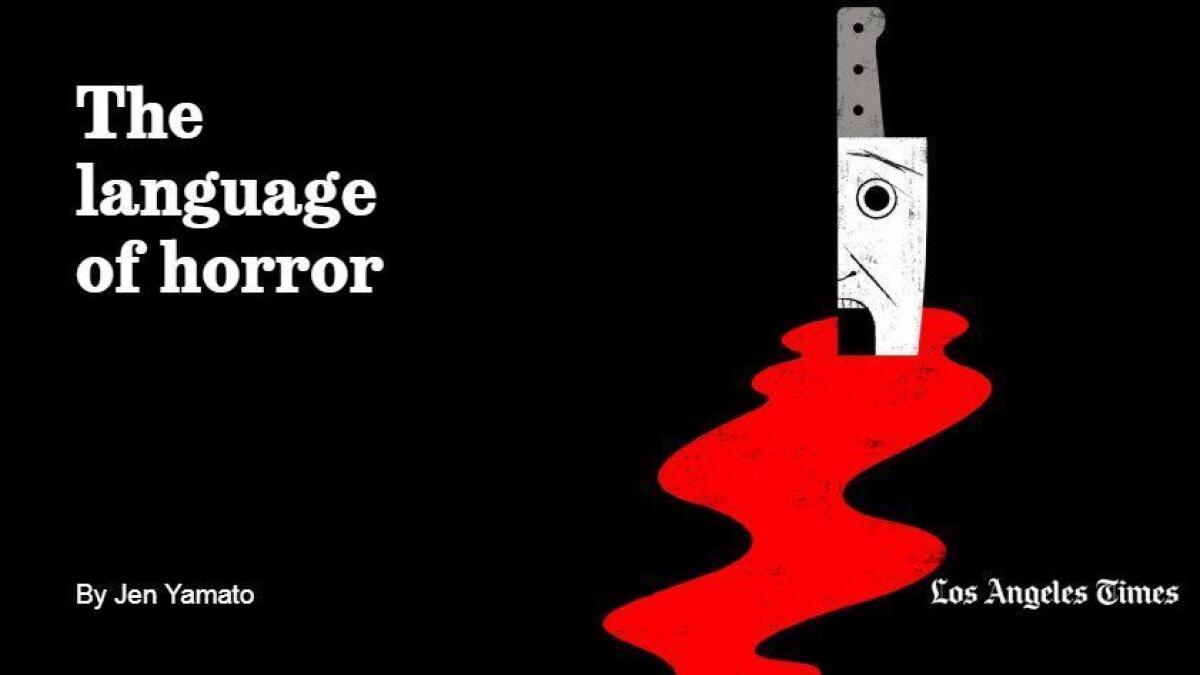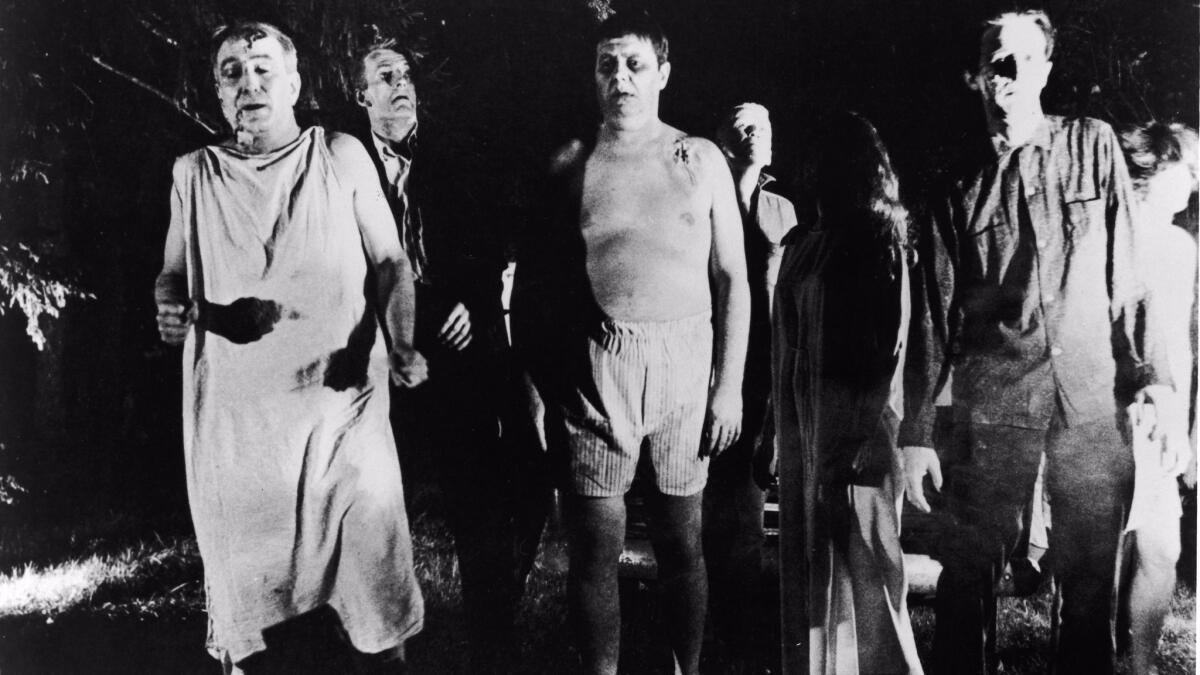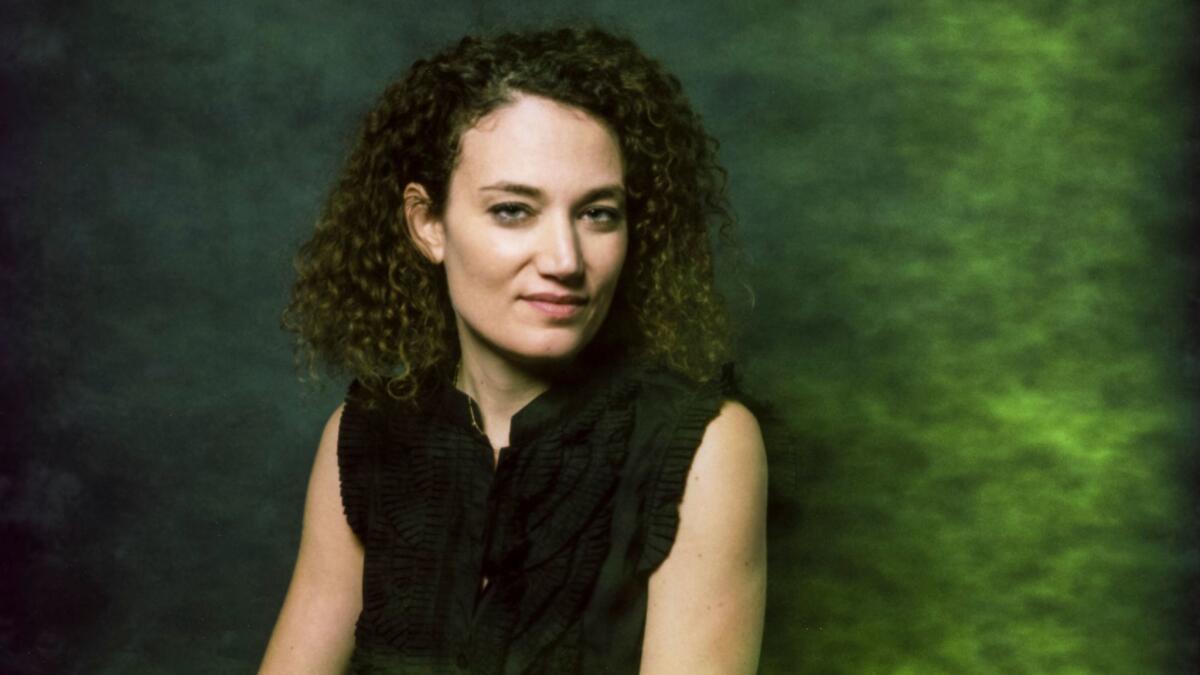Horror’s maestros on what drives the movies that scare us most

- Share via
They tap into our deepest fears as we sit in the dark and remind us, in brutal bursts and jump scares, how fleeting life can be. They give us bogeymen to rally against, heroines and heroes to root for. They teach us not to run away up the stairs or ever promise, as the shadows creep closer, “I’ll be right back.”
Drama may help us feel; a well-timed punchline has the power to unite. But horror, the “gutter” genre, the oft-maligned niche formerly reserved for B-movie bins and grindhouses, confronts us most boldly with our primal fears so that we may exhale with relief when the lights come back up — nerves rattled, hearts racing, minds turning over the questions we don’t dare speak out loud.
The translators, filmmakers who speak to us in the language of horror, are each in their own way part of a grand pop-folkloric tradition. It is the job of these macabre orchestra conductors to play our fears like violins, to choreograph our sense of dread as we sit in front of screens and spook us in the process — all in the name of entertainment.
“I learned the language of horror as a child at the movies and reading books,” says horror master John Carpenter, whose genre-blending career includes not only “Halloween,” “The Fog” and “They Live,” but “Escape From New York” and “Starman.”
Carpenter was weaned on the classic Universal monster movies and sci-fi horror of the 1950s, and also credits the literary influence of H.P. Lovecraft for forming his understanding of the genre. In turn, Carpenter’s influence, filtered through his own films, helped define horror for the filmmakers who followed.
Horror changes and gets reinvented each generation.
— John Carpenter, director
From the timely social commentary this year of Jordan Peele’s “Get Out” to the predatory clown terrors of the current smash hit “It,” even mainstream horror is finding ways to make scary movies fresh again. Game changers like the microbudget megahits “The Blair Witch Project” (1999) and “Paranormal Activity” (2007) are far and few between, initiating seismic shifts in the ways we create and consume horror. But in recent years, films such as “It Follows,” “The Witch” and “The Babadook” reset the indie horror bar, injecting thoroughly modern perspectives and rebellious creative vision back into a sprawling genre that’s seen it all over the decades.
“Horror changes and gets reinvented each generation,” Carpenter says. “It’s continually being modernized.”
Part of that reinvention comes from a broadening of sources as today’s horror stewards learn the language of fright.
“The first thing that ever scared me — that was structured like a horror film and featured everything that I thought a horror film could be — was an episode of ‘Fraggle Rock,’” confides “Oculus” and “Hush” director Mike Flanagan, who adapted the work of horror’s master novelist Stephen King for his latest film, “Gerald’s Game.”
The episode of the children’s show, titled “The Terrible Tunnel,” left an impression on Flanagan’s young mind. “The legend among the Fraggle community was that they would never come back. Our hero Fraggles went into the Terrible Tunnel and in it were the trapped spirits of other Fraggles,” Flanagan recalls, eyes wide. “Terrifying.”
Horror’s social revolution
Terrors of the real world have always made their way into our scary stories, even if in the worst of times, amid atrocities, disaster and tragedies beyond comprehension, the most horrific of movies can’t begin to compare. But our collective anxieties have a way of refracting their way into the cinema, in everything from zombie flicks to slasher pics, embodied in the monsters we see on screen.
Upstart American filmmakers of the 1960s and 1970s translated the turmoil of the outside world into their nightmarish film fantasies.
“If you were young and you were an artist, you were involved in the revolution, in the social change that was going on. And whether you thought about it or not, that fed the movies you were making,” says Mick Garris, whose genre credits include “Amazing Stories,” “Sleepwalkers,” “The Stand” and “Masters of Horror.”
Films like George A. Romero’s “Night of the Living Dead” (1968), Tobe Hooper’s “The Texas Chainsaw Massacre” (1974) and Carpenter’s “Halloween” (1978) rewrote what horror movies could mean as they reflected human and timely social anxieties back to their audiences.

“‘Night of the Living Dead’ … was much more graphic than people were used to,” says Garris, “and it was in the hands of a guy who had political thoughts even though he didn’t think he was putting them into his movie — about racism and about classism.”
Filmmaker Coralie Fargeat was raised in Paris on horror classics ranging from the body horrors of David Cronenberg to the final-girl heroics of Carpenter’s “Halloween.” In her own directorial debut, the upcoming female-driven vengeance tale “Revenge,” she deliberately subverts the way female bodies have been objectified onscreen by crafting a memorable sequence in which a man, not the female protagonist, is rendered stark nude and vulnerable.
Like recent standouts “Raw” and “The Babadook,” her “Revenge,” a boldly stylistic thriller about a young woman who turns the tables on her male abusers, is not only a reinterpretation through a female lens of the cinematic language of horror films — and rape-and-revenge movies like “The Last House on the Left” (1972) and “I Spit on Your Grave” (1978) — but a reclamation of the male-dominated genre itself.

“I think what’s really powerful in horror and genre film is that it really relates to our inner fears, to our societal fears, fears of not fitting into a mold, fear of being rejected, to be invaded, to be seen as a monster, to be judged,” she says. “I found it a very cathartic way to explore our fears and desires, or questions we can’t process in one way or another.”
As a child, Garris says, he found comfort in classic Universal monsters like Frankenstein, the original misunderstood outsider.
“I think you’ll find most of the creatives in the genre were not crowned prom king or queen,” Garris says with a laugh. His upcoming anthology, “Nightmare Cinema,” assembles new terror tales from an international slate of directors. “It’s really brave to be able to be as open about things that other people would keep hidden.”
Fear and mystery
Each horror filmmaker speaks a unique dialect cultivated from his or her own curiosities, influences, culture and generation. But the desire they share is universal: to scare us silly, to entertain, to guide us through our unspeakable fears and to remind us, consciously or otherwise, that unlike many an unlucky soul left behind onscreen, we are the ones yet alive.
“I think it’s because fear is an emotion all humans know,” Carpenter says. “Essentially we’re all afraid of the same things.”
Horror, says director Stuart Gordon, “is about scaring people; isn’t that what we’re trying to do?”
He first did that in 1985’s “Re-Animator,” the tale of H.P. Lovecraft’s mad scientist Herbert West, who brings the undead back from the grave with disastrous results.
It was another science-gone-wrong classic, William Castle’s 1959 bum-buzzer “The Tingler,” that tutored Gordon as a boy. Forbidden from seeing scary movies by his parents, he’d snuck into “The Tingler” mid-movie just in time to catch its most terrifying scene, in which a woman is literally frightened to death.
“I jumped out of my seat and ran out of the theater, I was so scared,” Gordon remembers. “I thought, ‘Oh my god, is the whole movie going to be like this?’ I couldn’t handle it. And that was the beginning of realizing that was the secret: To let the audience’s imagination do all the work.”
The dread of the unknown is what hooked Don Coscarelli as a child watching the sci-fi horror chills of films like “Quatermass 2,” the 1957 black-and-white British picture about aliens that helped buoy the Hammer Film Production hit factory.
He’d later infuse his “Phantasm” films with a similar left-field sensibility leaning on the thrill of the unexpected.
“I think mystery is a real component to horror, because you need a mystery before you can be put on edge,” he explains. “You’re trying to fill in the blanks from your own imagination; suspense, misdirection and not answering questions forces you to have a running dialogue with yourself, in your mind, as the film’s unfolding.”
The recent resurgence of the horror anthology continues a storytelling tradition passed down and transmuted through generations of genre creators. It’s a lineage that director and “V/H/S” producer Roxanne Benjamin traces back to the mid-century tales spun in the pages of EC Comics.
“‘Vault of Horror’ … the ‘Tales from the Crypt’ shows and ‘Creepshow’ all had a pulpy sensibility to them and some sort of morality lesson,” she explains. Their formats inspired updated takes on the anthology with modern twists that indie film audiences embraced at the Sundance and Toronto film festivals. Videotapes link the narratives of the “V/H/S” series of films, for example, while the omniscient voice of a radio DJ threads disparate tales, including one directed by Benjamin, in “Southbound.” “XX” boasts segments by an all-female lineup of directors, including Benjamin, Karyn Kusama, Jovanka Vuckovic and Annie Clark, aka musician St. Vincent.
Learning to speak the language of horror as a filmmaker means becoming fluent in how we relate to fear, says Neil Marshall (“The Descent”), who is currently directing the “Hellboy” reboot for Lionsgate.
“Humans are in many ways cursed by self-awareness — the idea that we are mortal and we are all going to die eventually, and nothing can prevent it,” he says. “But even knowing this, we try to live as long as we can. There’s an instinct buried deep within every living thing, right at the root of our being: self-preservation. Horror taps into this instinct and uses it against us. We need to feel afraid to remind us we’re alive.”
Drama in the splat
Affirming our own mortality has always been one of horror’s subconscious ends. The genre externalizes our anxieties and allows us to exorcise their manifestations onscreen. That’s why horror is an international language.
Scares travel for deeper reasons than sweaty palms, says Dario Argento, master of the Italian giallo, distinguished by impressionistic colors, erotic thrills and black-gloved mystery.
“I throw out all my bad feelings and people discover it touches something in their souls, the same sentiment, the same emotions, it is inside them too,” he says during a recent visit to Los Angeles for the Beyond Fest screenings of his 1977 ballerina horror classic, “Suspiria.”
“Everybody watches a horror film — a good horror film, not these stupid things, but something good — with psychology, with heart, they discover a sincerity,” he adds. “If you are sincere, the film can be great. If you’re not sincere, it doesn’t work.”
Tobe Hooper, in an article written for The Times several years after his influential “Texas Chain Saw Massacre” earned newfound respect, argued that his film “was more complex than it seemed.” He detailed the deceptively artful ways in which the cannibal classic suggests rather than depicts horrors so vivid viewers frequently misremembered how gory it really was: “The real horror of the film is psychological.”
Those who craft scary movies know it is just as hard to pull off as comedy, and just as effective as drama when done well.
“The bad horror filmmakers think it’s all about the splat,” says Garris. “The good ones know it’s harder to make a good horror movie than it is to make a good drama, because it has to be a good drama first.”

A thousand “scare-actors” a night wend through an assembly line of gore, where they are transformed into terrifying characters for Universal Studio’s Halloween Horror Nights.
“The exciting thing about the genre is that it looks for new ways to express the internal and make it external,” says Garris.
It was “Bad Taste,” the gross-out debut film from future “Lord of the Rings” Oscar-winner Peter Jackson, that showed filmmaker Ti West (“The House of the Devil,” “The Sacrament,” “The Innkeepers”) how making movies was possible as a kid growing up in Delaware, far from the glitz of the Hollywood studios.
“It was very liberating to me to see that you didn’t have to be somebody off in Hollywood. That was the first movie that made me think, I’m going to try this,” said West, whose latest film, “In a Valley of Violence,” spins a Western pastiche. “And I only came to that movie because I heard it was the grossest movie ever; I wanted to dare myself to see it. And when I did, it … changed the way my brain worked.”
Notes Flanagan, whose genre influences in fact do reach beyond “Fraggle Rock” — to Carpenter, Hooper, Romero, William Friedkin and Wes Craven, plus stories by King — horror “is a powerful tool of self-understanding.”
“It’s a reflective surface for our society,” he says. “A place where we can put our darkest impulses, our biggest failings, our deepest fears, our most rotten selves — the things that we fear the most.”

Universal Studios pulls out the knives, axes and pig heads to scare you silly
Times staff writer Mark Olsen contributed to this story.
ALSO:
A timeline of horror movies and moments
The Pennywise presidency and why horror is the movie genre of the moment
Why this film critic won’t see any more horror movies
The ‘American Horror Story’ cast gets a taste of its own medicine at Roanoke maze
TV horror vs. movie horror: Guillermo del Toro on telling scary stories across different mediums
More to Read
Only good movies
Get the Indie Focus newsletter, Mark Olsen's weekly guide to the world of cinema.
You may occasionally receive promotional content from the Los Angeles Times.









